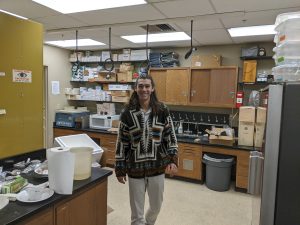WSU student tests Styrofoam-eating mealworms as protein source
Mealworms assigned four different diets of Styrofoam, chicken, potatoes; four groups had similar death rates
Mealworms that had a Styrofoam-only diet began to eat each other to get nutrients. Mealworms that ate Styrofoam and chicken appeared healthy.
September 2, 2020
WSU master’s student Brenden Campbell began researching mealworms, a type of beetle larvae, for his Honors College thesis after he saw a Stanford research article showing mealworms can digest polystyrene, better known as Styrofoam.
“My mind started spinning,” Campbell said. “If they can do that … Can we do this for food? Is that a possibility?”
Campbell said he wanted to find out if mealworms could be used as a viable protein source if they were fed trash, specifically Styrofoam, which takes up about one third of U.S. landfills by volume. Microbes in their digestive tract help mealworms break down polystyrene.
To test his question, Campbell set up four different diets for mealworms: Styrofoam only, chicken feed only, Styrofoam mixed with chicken feed, and Styrofoam mixed with potatoes. He measured each group’s weight, activity level and other indicators of nutrition, he said.
All four diets had similar death rates, but the Styrofoam alone was not nutritious enough for the mealworms, Campbell said. They began to eat each other to get needed nutrients.
However, the mealworms consuming Styrofoam mixed with chicken feed appeared to be healthy and consumed more Styrofoam than the Styrofoam only group.
“They have decent protein and really good fat,” he said. “They are overall a better worm.”

Campbell hopes to do further testing with multiple generations of mealworms. A mealworm farm using polystyrene and another food source could be a potential for alternative protein, he said.
Nancy Irlbeck, clinical associate professor in WSU’s Department of Animal Sciences and Campbell’s thesis adviser, said mealworms may be consumed more as the global population increases. With more people in the world and less land available, bugs could be a sustainable supplement to other protein sources because they require minimal resources to mature.
Campbell, who studies environmental sciences, said he wants to make sure he is not creating more of an environmental problem while addressing another. For example, Styrofoam flaking can occur when mealworms move through the material as they eat it, causing small chunks to break off. These chunks can enter the environment and be blown around by wind.
As he continues his research, Campbell said he hopes to examine different aspects and the “what ifs” of using mealworms as an alternate protein.
Interdisciplinary collaboration, such as Campbell’s environmental science perspective paired with Irlbeck’s animal science background, could be the solution to future world problems, Irlbeck said.
“My hope for the alternate protein is that insects don’t become this novelty item,” Campbell said, “but they become something that’s on the main menu.”
This article has been updated to correct the amount of Styrofoam in landfills.












